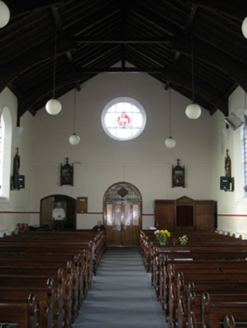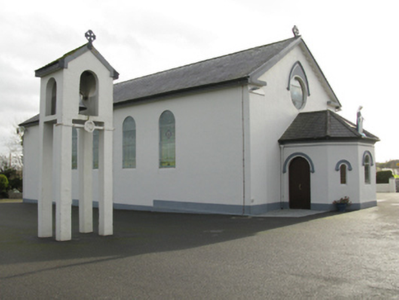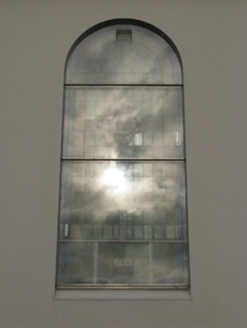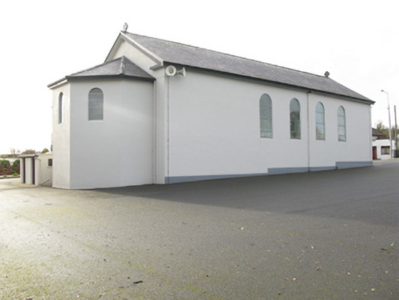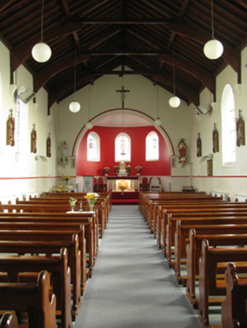Survey Data
Reg No
31308201
Rating
Regional
Categories of Special Interest
Architectural, Artistic, Historical, Social, Technical
Previous Name
Saint Mary's Catholic Church
Original Use
Church/chapel
In Use As
Church/chapel
Date
1920 - 1930
Coordinates
149711, 286823
Date Recorded
18/11/2010
Date Updated
--/--/--
Description
Detached five-bay double-height Catholic church, designed 1924; built 1924-5; opened 1926, comprising four-bay double-height nave opening into single-bay double-height apse (east) on a half-octagonal plan with single-bay single-storey projecting porch to entrance (west) front on a half-octagonal plan. Renovated, ----, with sanctuary reordered. "Improved", 2000[?]. Pitched slate roof overhanging half-octagonal slate roof (east) with half-octagonal slate roof to porch, clay ridge tiles terminating in cut-limestone Celtic Cross finials to apexes, dentilated open bed pediment to gable to entrance (west) front, and replacement uPVC rainwater goods on eaves boards on box eaves retaining cast-iron conical hoppers and downpipes. Rendered, ruled and lined walls on rendered plinth with rendered buttresses to entrance (west) front having rendered coping. Round-headed window openings with concealed dressings framing storm glazing over fixed-pane fittings having stained glass margins centred on leaded stained glass quatrefoils. Round-headed window openings to apse (east) with concealed dressings framing storm glazing over fixed-pane fittings having stained glass margins centred on leaded stained glass panels. "Rose Window" to gable to entrance (west) front, concealed dressings with pointed hood moulding over framing storm glazing over fixed-pane fitting having stained glass margins centred on stained glass roundel. Round-headed window opening to porch, concealed dressings with hood moulding over on label stops framing storm glazing over fixed-pane fitting having leaded stained glass panel. Round-headed opposing door openings to "cheeks", concealed dressings with hood mouldings over on label stops framing timber boarded or tongue-and-groove timber panelled double doors. Interior including vestibule (west) with stained glass window (1946); round-headed door opening into nave with glazed timber panelled double doors having overlight centred on leaded stained glass quatrefoil; full-height interior open into roof with stained glass "Rose Window" (west), carpeted central aisle between trefoil-detailed timber pews, Gothic-style timber stations between stained glass memorial windows (undated), exposed braced collared timber roof construction on corbels with wind braced rafters to timber boarded ceiling, and round-headed chancel arch framing carpeted stepped dais to sanctuary (east) reordered, ----, with carpeted stepped "predella" supporting cut-veined white marble panelled altar below stained glass windows (1926). Set in own grounds.
Appraisal
A church representing an integral component of the early twentieth-century ecclesiastical heritage of County Mayo with the architectural value of the composition, one erected to a design (1924) attributed to Rudolph Maximilian Butler (1872-1943) of Kildare Street, Dublin (Irish Builder 1924, 411), suggested by such attributes as the rectilinear "barn" plan form openings into a polygonal apse; and the "arcaded" profile of the openings underpinning a streamlined Romanesque theme. Having been well maintained, the elementary form and massing survive intact together with substantial quantities of the original fabric, both to the exterior and to the interior reordered (----) in accordance with the liturgical reforms sanctioned by the Second Ecumenical Council of the Vatican (1962-5) where contemporary joinery; stained glass (1926) attributed to Joshua Clarke and Sons (established 1892) of North Frederick Street, Dublin (MCC); and later stained glass (1946) attributed to the Harry Clarke Stained Glass Studios (closed 1973) of Dublin (ibid.), all highlight the artistic potential of the composition: meanwhile, an exposed timber roof construction pinpoints the engineering or technical dexterity of a church making a pleasing visual statement in a rural street scene.
